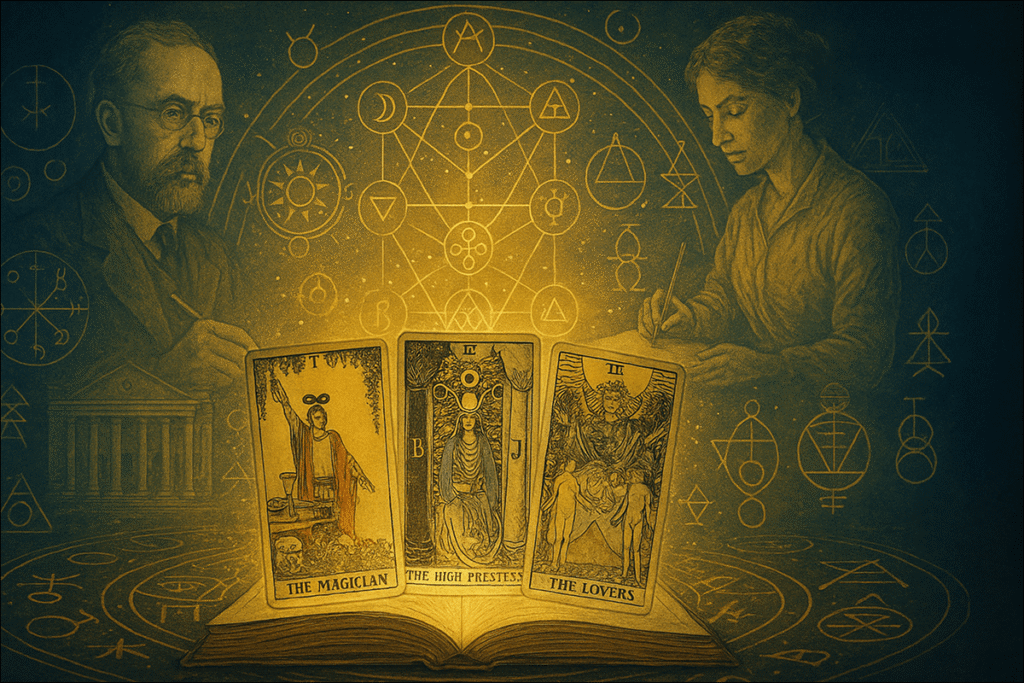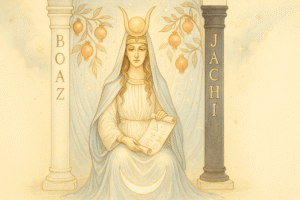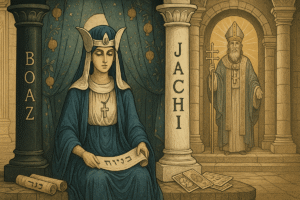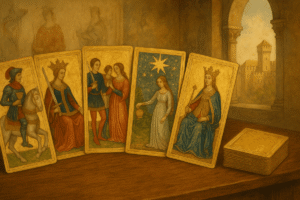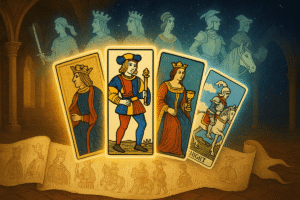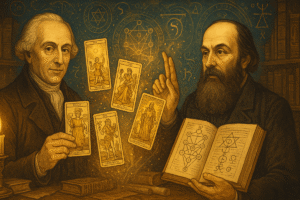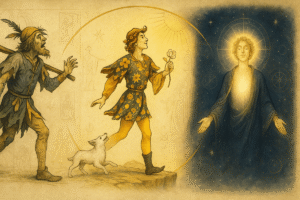Table of Contents
When I first started exploring tarot seriously, I kept noticing these intricate symbols everywhere on the Rider-Waite-Smith cards. The Hebrew letters, the astrological glyphs, those mysterious geometric patterns. It wasn’t until I stumbled upon the history of the Hermetic Order of the Golden Dawn that everything started clicking into place. Perhaps you’ve wondered about these symbols too?
The connection between the Golden Dawn and the creation of what we now call the Rider-Waite-Smith tarot is one of the most fascinating stories in esoteric history. This isn’t just about card meanings or spreads. It’s about how an entire magical system got carefully woven into 78 pieces of cardboard that millions of people now use for reflection and personal insight.
The Golden Dawn Foundation
The Hermetic Order of the Golden Dawn emerged in 1888 London, founded by three Freemasons who claimed to possess ancient magical manuscripts. William Wynn Westcott, Samuel Liddell MacGregor Mathers, and William Robert Woodman created what would become the most influential magical society of the modern era.
What made the Golden Dawn different from other occult groups was their systematic approach. They didn’t just collect mystical traditions haphazardly. Instead, they created an organized curriculum that synthesized Kabbalah, astrology, alchemy, Egyptian mythology, and Christian mysticism into a coherent magical system. Think of it as a graduate program in esoteric studies, complete with examinations and degrees.
The society attracted some remarkable minds. Poet William Butler Yeats was a member, as was actress Florence Farr and writer Algernon Blackwood. But for our story, the most important members were Arthur Edward Waite and Pamela Colman Smith, who would later collaborate on the most famous tarot deck in the world.
By the time Waite and Smith joined, the Golden Dawn had developed incredibly detailed correspondences between tarot cards and their magical system. Every card had been assigned specific astrological associations, Kabbalistic pathways, and alchemical principles. This wasn’t casual symbolism. It was a precise magical alphabet.
Arthur Edward Waite’s Vision
Waite joined the Golden Dawn in 1891, though his relationship with the order was complicated. He was deeply scholarly, perhaps overly so for some of his fellow members. Waite had strong opinions about how esoteric knowledge should be presented to the public. He believed that mystical wisdom could be shared more openly than the secretive Golden Dawn typically allowed.
When Waite decided to create his own tarot deck in 1909, he wasn’t starting from scratch. He was drawing upon nearly two decades of Golden Dawn teachings, but he wanted to make those teachings accessible to people outside magical circles. This created an interesting challenge. How do you encode advanced esoteric knowledge into images that ordinary people can understand and use?
Waite’s solution was brilliant. He would embed the Golden Dawn’s symbolic system right into the artwork, but in ways that wouldn’t require formal magical training to appreciate. Someone could use the cards for personal reflection without needing to understand that the Fool’s yellow sky represents the element of Air, or that his white rose symbolizes pure desire.
I find it fascinating how Waite balanced these two audiences. The cards work perfectly well as psychological tools for self-reflection. But they also function as a complete magical textbook for those who know how to read the symbols. It’s like having a conversation that operates on multiple levels simultaneously.
Pamela Colman Smith’s Artistic Genius
While Waite provided the symbolic framework, Pamela Colman Smith brought the vision to life. Smith, known as “Pixie” to her friends, was an accomplished artist and fellow Golden Dawn member. She had studied at the Pratt Institute and was deeply influenced by the Arts and Crafts movement and Japanese woodblock prints.
Smith’s contribution often gets overlooked, which seems unfair given how recognizable her artistic style remains today. She created 78 detailed illustrations in just six months, working from Waite’s sometimes cryptic instructions. The publisher paid her a flat fee with no royalties, a decision that would cost her enormously as the deck became the world’s most popular tarot.
What made Smith’s artwork revolutionary was her decision to illustrate all the pip cards, not just the major arcana and court cards. Previous tarot decks typically showed only the appropriate number of suit symbols on the numbered cards. Smith created complete scenes for every single card, embedding layers of Golden Dawn symbolism into each image.
Take the Three of Pentacles, for example. Smith shows three figures collaborating on building a cathedral. The scene suggests teamwork and skill development, certainly. But look closer at the Golden Dawn correspondences. This card represents Mars in Capricorn, the dynamic energy of Mars channeled through Capricorn’s practical, building-oriented nature. The cathedral itself becomes a symbol of the Great Work, the alchemical process of spiritual transformation.
Kabbalistic Pathways Hidden in Plain Sight
The Golden Dawn’s magical system was heavily influenced by the Kabbalah, the mystical tradition of Judaism. The society taught that the 22 major arcana cards correspond to the 22 pathways on the Kabbalistic Tree of Life, connecting the ten spheres or sephiroth.
This isn’t just theoretical correspondence. The Golden Dawn assigned specific Hebrew letters to each major arcana card, and Smith incorporated these associations into her artwork. The Fool carries the Hebrew letter Aleph, representing the element of Air and the pathway between the Crown and Wisdom on the Tree of Life. His position at the cliff’s edge suggests the leap of faith required for spiritual initiation.
The Magician holds the Hebrew letter Beth, meaning “house” and representing the planet Mercury. Notice how Smith shows him with one hand pointing up and one down, embodying the Hermetic axiom “As above, so below.” The infinity symbol above his head and the roses and lilies in his garden all carry specific Kabbalistic meanings that Golden Dawn members would have recognized immediately.
Perhaps most intriguingly, the ordering of the major arcana itself reflects the Golden Dawn’s understanding of the spiritual journey. The cards progress through different levels of consciousness and spiritual development, from the Fool’s initial innocence through the World’s final integration. Each card represents both a stage in this journey and a specific type of energy or consciousness that the practitioner might need to understand or embody.
Astrological Wisdom in Every Card
The Golden Dawn created detailed astrological correspondences for every single tarot card. The major arcana were assigned to planets, zodiac signs, and elements. The minor arcana followed an intricate system that divided each astrological sign into three parts, called decans, with each decan governing a specific numbered card.
Smith embedded these astrological associations throughout her artwork. The Emperor sits on a throne decorated with ram’s heads, connecting him to Aries, his assigned zodiac sign. The Star shows Aquarius, the water bearer, pouring water under a starry sky. These aren’t just decorative choices. They’re a complete astrological education hiding in plain sight.
The minor arcana’s astrological system is even more sophisticated. The Two through Ten of each suit represent the 36 decans of the zodiac, with specific planetary rulers for each card. The Five of Cups, for instance, represents Mars in Scorpio, which explains the card’s themes of emotional conflict and the need to process difficult feelings before moving forward.
I sometimes wonder if Smith fully grasped how comprehensive this system was. She was working from Waite’s instructions, but she also brought her own intuitive understanding to each image. The result feels both systematic and organic, as if the symbols naturally belong together.
Alchemical Transformations
Alchemy provided another layer of symbolism that the Golden Dawn wove into their tarot system. The medieval art of transformation, both physical and spiritual, offered rich metaphors for psychological and magical development. Smith’s artwork is filled with alchemical symbols that speak to processes of change and growth.
The Death card provides an obvious example. Rather than showing literal death, Smith depicts a knight in black armor representing the alchemical stage of nigredo, the necessary dissolution that precedes rebirth. The rising sun in the background suggests the albedo stage, the purification that follows. The whole image becomes a map of psychological transformation.
Less obviously, many cards contain subtle alchemical references. The Temperance angel combines fire and water, representing the fundamental alchemical process of balancing opposites. The Hermit’s lantern contains a six-pointed star, the alchemical symbol for the union of fire and water, masculine and feminine, conscious and unconscious.
These alchemical themes run throughout the deck because the Golden Dawn viewed tarot as a tool for personal transformation. Each card doesn’t just describe an external situation; it also represents an internal process or state that the querent might need to explore or integrate.
The Enduring Legacy
What strikes me most about the Golden Dawn’s influence on the Rider-Waite-Smith deck is how successfully it bridges different worlds. The cards work beautifully for someone approaching them purely as tools for self-reflection and personal insight. The imagery is rich enough to trigger meaningful introspection without requiring any specialized knowledge.
Yet for those who choose to dive deeper, the Golden Dawn’s symbolic system offers layers upon layers of additional meaning. You could spend years studying the Kabbalistic, astrological, and alchemical correspondences without exhausting their possibilities. It’s like having a library encoded in pictures.
This dual accessibility might explain why the Rider-Waite-Smith deck has remained so popular for over a century. Waite and Smith created something that grows with the user. The more you bring to the cards, the more they seem to offer back. But they never require more than you’re ready to explore.
The Golden Dawn’s systematic approach also set a standard for modern tarot deck creation. Contemporary deck creators still reference these symbolic correspondences, either following them closely or consciously departing from them. The Golden Dawn’s influence extends far beyond this single deck into the entire modern tarot revival.
Perhaps that’s the real magic at work here. The Golden Dawn took ancient wisdom traditions and found a way to preserve them in a form that could speak to future generations. They created a symbolic language that remains vibrant and meaningful more than a century later.
When you shuffle a Rider-Waite-Smith deck today, you’re not just mixing 78 cards. You’re engaging with a carefully constructed system of symbols that carries forward thousands of years of human wisdom about transformation, growth, and the mysterious patterns that seem to connect inner and outer experience.
Maybe that’s worth reflecting on the next time you lay out a spread. What conversations might these symbols be trying to start with you?
Frequently Asked Questions
Do I need to understand the Golden Dawn symbolism to use the Rider-Waite-Smith deck?
Not at all. One of the brilliant aspects of this deck is that it works beautifully on two levels. You can use it purely for personal reflection and the imagery alone will speak to you meaningfully. The Golden Dawn correspondences are there for those who want to explore deeper layers, but they’re completely optional. Think of them as bonus content that enhances your understanding over time rather than prerequisites for getting started.
Why did Waite switch the order of Strength and Justice cards?
Waite changed their positions to align with the Golden Dawn’s astrological correspondences. By making Strength card 8 and Justice card 11, he connected Strength to the zodiac sign Leo (the lion) and Justice to Libra (the scales). Traditional Marseille decks had them the other way around, but Waite felt this new ordering created a more coherent symbolic system that matched the natural progression of the zodiac signs through the major arcana.
Is the Rider-Waite-Smith deck the same as the Golden Dawn Tarot deck?
No, they’re different decks entirely. The Golden Dawn Tarot (also called the Hermetic Tarot) was an esoteric deck designed specifically for members of the Order and features very detailed occult symbolism. The Rider-Waite-Smith deck took those same Golden Dawn teachings but made them more accessible through Pamela Colman Smith’s approachable artwork. You could think of the RWS as a more user-friendly version that encoded the same wisdom in a way that works for everyone, not just ceremonial magicians.

